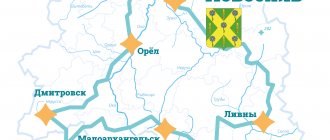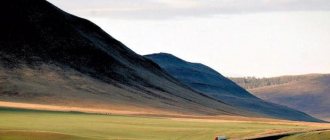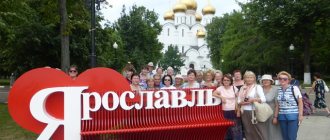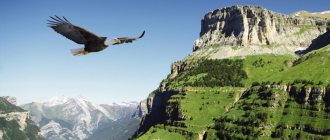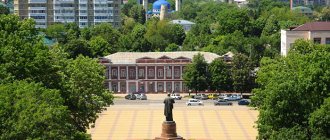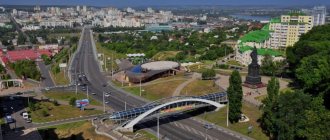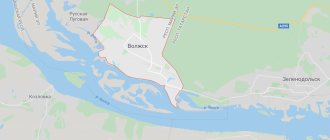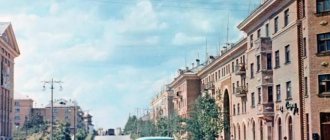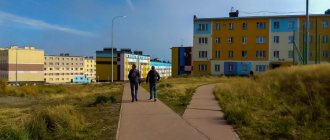Corners of Russia: the lost city of Kologriv
Author Yuri Sosinsky-Semikhat
05.07.2012 17:30
Society » Practice » How to relax
Lost in the forests in the north of the Kostroma region is the small town of Kologriv. Getting there is not easy, but it’s worth it: you find yourself in another world, mothballed decades ago and retaining the charm of the past. True, tourists rarely come here. But the old charm does not work on the local population, which is why the Kologriv residents leave.
You can only get to Kologriv by bus from the Manturovo railway station. Local legend says that once one of the patrons of the Kostroma province decided to build a railway here. The station building was erected, but the rails were never laid—the money ran out. This is how the legendary Kologriv station appeared, from which trains do not depart. “In the last century it was used as a bus station,” old-timers recall. Now the bus only runs twice a week. In addition, there is a transit flight Kostroma - Kologriv, once a day, late in the evening.
Tourism in Kologriv
The town of Kologriv, located in the northeast of the Kostroma region, is a typical Russian province, a classic wilderness and “bear corner”. The roads here are very bad, to put it mildly, a depressed economy and a neglected appearance of dying settlements. All this is true, but at the same time, there are many amazing things on the Kologriv land, for which you can come to this protected corner of the Russian land. The Kologrivsky district is widely known in our country and abroad as the “goose capital of Russia”; the state nature reserve “Kologrivskaya Poima” is the only place in our country where thousands of wild geese live in the spring almost within the city limits. In our area, the only relict taiga in Europe has been preserved, which has never known fires or deforestation; now it is the Kologrivsky Forest state nature reserve. Kologriv land is the birthplace of the unique artist, thinker and righteous man Efim Chestnyakov, whose work is actively studied and preserved in the region. And the collections of the Kologriv Local History Museum named after G.A. Ladyzhensky, which is the only station of its kind without a railway, could be a credit to any museum, even the capital’s. There are other interesting museums in our area, the exhibitions of which will not leave anyone indifferent. The heritage left to us by previous generations is carefully preserved here. The regional center of Kologriv, which has preserved to this day the unique appearance of a small county merchant town with dozens of monuments of provincial architecture, is invariably popular among tourists. Arriving in Kologriv, you should definitely visit the Princely Hermitage, where there once was a monastery located on a high mountain in a very picturesque place. Let us not forget the village of Ekimtsevo, on the territory of which the first and best agricultural and technical school named after F.V. Chizhov was once located in the Russian Empire, which had an excellent educational, technical and natural-architectural base. We have ancient villages with beautiful churches, former noble estates with a rich history, and beautiful white forests, as well as other natural attractions.
Kologriv. View from the bridge
Thanks to the diversity of natural landscapes, the area has all the opportunities for active sports and recreation at any time of the year, such as kayaking, catamarans and other watercraft along the Unzha and its tributaries, trophy raids on off-road vehicles in “impassable” places, horseback riding tours , cycling excursions, skiing in pine forests. Our land is attractive for fishermen and hunters, lovers of “silent hunting” and other gifts of nature. The wealth of cultural heritage and natural resources make cultural, educational, event, pilgrimage, sports, environmental, ethnographic and other types of tourism possible in our area. Of course, we have something to show tourists and we always welcome guests! We invite travel lovers to visit the Kologrivsky district - a protected region of Russia!
Kologriv from a goose flight
10 reasons to come to Kologriv
Reason 1. Station without a railway
The city of Kologriv is the only place where there is a railway station without a railway. Now the local history museum named after G.A. Ladyzhensky is located here - the pride of Kologriv residents and one of the best regional museums in Russia. The museum was founded by academician of painting, “king of watercolors” Gennady Ladyzhensky. The spacious halls of the old merchant mansion display exhibitions on the history and nature of the local region. In the excellent art department you can see paintings by Russian artists: Kramskoy, Shishkin, Bryullov, Fedotov, Shevchenko, Borovikovsky and others, as well as Western European painting of the 16th – 19th centuries. Much attention is paid to the work of two famous Kologriv artists - G.A. Ladyzhensky and E.V. Chestnyakova.
Museum named after Ladyzhensky
Reason 2. Goose kingdom
The city of Kologriv is the only place in the world where every spring thousands of wild geese live almost within the city limits. The Kologrivskaya Poima ornithological reserve, where geese and other birds live from April to mid-May, has been declared a specially protected natural area. In honor of migratory birds, an interesting holiday, Goose Day, is held in early May, and the city itself rightfully bears the title of “Goose Capital of Russia.”
Goose reserve
Reason 3. Relic taiga
In the vicinity of Kologriv, the only area of primeval taiga in Europe has been preserved, which has never known deforestation or forest fires. A hybrid species of Kologriv spruce grows here (Siberian spruce and Norway spruce “are found” in Kologriv), reaching enormous sizes. Now this site is under state protection on the territory of the Kologrivsky Forest named after M.G. Sinitsyn reserve. The staff of the institution conduct excursions in the reserve.
Reserve
Reason 4. Fairytale artist Chestnyakov
Kologriv land is the birthplace of the unique peasant artist, poet, thinker and righteous man Efim Chestnyakov, whose work is actively studied and preserved in the region. In the house-museum of E.V. Chestnyakov in the village of Shablovo you can get acquainted with the life and work of this amazing person, see original things, paintings, drawings and sculptures of the artist. You can get acquainted with the amazing and interesting world of the old Russian village in the ethnographic hut, where museum staff conduct interactive programs and even treat you to a delicious peasant lunch from a Russian oven.
Efim Chestnyakov Museum in Shablovo
Reason 5. County town of Kologriv
Kologriv is one of the smallest cities in Russia; it has retained to this day the unique appearance and charm of a small provincial merchant town. Here you will not see public transport, Khrushchev buildings, typical Soviet buildings, bustling crowds of people and industrial buildings, but you can admire dozens of monuments of provincial architecture. Walking around Kologriv, which has an integral architectural ensemble, you will certainly feel like a time traveler who, by the will of fate, found himself in the 19th century.
Reason 6. Princess of the Deserts
To the north-east of Kologriv, among the endless taiga, on the top of a high mountain there is the Princely Monastery, a former monastery. There is amazingly beautiful nature here, a historical place covered in legends and traditions. For centuries, pilgrims from different parts of the Russian state have sought to come here. Under the Holy Mountain, to the left of the churches, there are holy springs, the water in which is considered healing and holy. Once upon a time, huge holy linden trees grew on the mountain, gnawed by the teeth of thousands of pilgrims - it was believed that the bark of these trees could relieve toothache. The descendants of the holy linden trees still grow near the temples. In recent years, a chapel has been built here, the holy springs have been improved, a bathhouse has been built, and a guest house for pilgrims has been built.
Princess of the desert. Apse of the Assumption Church
Reason 7. Chizhovsky complex
One of the most interesting places in the Kologrivsky district is the village of Ekimtsevo, where since the end of the 19th century. the Agricultural School named after F.V. Chizhov was located - one of the best vocational educational institutions in pre-revolutionary Russia. The beauty and pride of the village is the main educational building, built in 1891-92 according to the design of the famous architect I.V. Shtrom. The impressive two-story building on semi-basements is richly decorated with exposed brickwork. Large lancet windows and other architectural details make it look like a Gothic medieval castle.
Reason 8. Monster
The dense forests in the north of the Kologrivsky district near the Markhanga and Stepanovka rivers are a place where a mysterious three-meter creature covered with fur has been seen more than once. In different parts of the Earth this creature is called Yeti, Bigfoot, Sasquatch, Almasty, and the Kologriv Bigfoot was nicknamed “monster” by local residents. There is an excursion “In Search of the Beast” to the places where Bigfoot lives, and who knows, maybe you will be “lucky” to see the owner of the forest. The spectacle, however, is not for the faint of heart and remains in the memory for a lifetime. In honor of the local yeti cub Snezhka, Kologriv residents hold a fun holiday “Kologriv Snowball Day” at the beginning of January.
Reason 9. Unzha River
The Unzha River, which flows through the entire region, is amazingly beautiful and picturesque. Unzha is an ideal place for water sports tourism. Along the entire length of the river there are many beautiful and convenient places for parking, as well as beautiful sandy beaches. There are many sights along the way: ancient villages with preserved temples, the village of Shablovo - the birthplace of E.V. Chestnyakov, the original Kologriv - a fortress on the border with the Kazan Khanate, the village of Ekimtsevo, where the beautiful educational park complex of the former Chizhov Agricultural School is located, the ancient cities of Kologriv and Makariev. In many places there are deposits of fossil rocks from the Jurassic period; you can easily find ammonites, which locals call “urash stones”, as well as belemnites – “devil’s fingers”. The main fish species in the river are chub, pike perch, asp, burbot (cod family), perch, dace, bream, ide, pike, and sorog.
Unzha River
Reason 10. Kologriv nature
The nature of the Kologriv land is wonderful; it’s not for nothing that our region is called the “Reserved Land of Russia.” Beautiful white moss forests, picturesque forest rivers, an abundance of animals, berries and mushrooms invariably attract numerous nature lovers, outdoor enthusiasts, as well as fishermen and hunters to Kologriv. The area has interesting natural sites, for example, former lordly parks and alleys, cranberry bogs, a unique huge pine tree in the village of Urma, included in the register of old-growth trees in Russia, and many others.
Pine in Urma
The Kologriv region is an endless taiga, clean air, crystal water of forest rivers, holy places and unique natural sites, hunting and fishing, wonderful architectural monuments, talented craftsmen preserving the traditions of their ancestors and much, much more. Be sure to come visit us and see for yourself! Welcome to Kologriv!
How to get to us
Kologrivsky district is located in the northeast of the Kostroma region, 360 km from Kostroma, 640 km from Moscow, 90 km north of the city of Manturovo (station of the Northern Railway). You can get to Kologriv as follows. By train to the Manturovo railway station (10-12 hours from the Yaroslavl station in Moscow). From there to Kologriv 2 times a week (Tuesday and Thursday, 8-15 and 12-50) there is a regular bus. You can take a taxi at the station (1200-1500 rubles). In addition, a regular bus Kostroma - Kologriv passes through the Manturovo station every evening. By road from Moscow you need to go along the Yaroslavskoe highway to Kostroma, then along the Kostroma - Verkhnespasskoye highway to the village of Elizarovo, Manturovo district. Behind the bridge over Unzha there will be a turn to Kologriv along the Elizarovo - Kologriv road (50 km). A regular bus runs daily from Kostroma to Kologriv. Departure from the bus station at 16-00. From Kologriv to Kostroma - at 4:50 (on Sunday - at 13:00).
Cost of services for tourists
Excursions
— Local Lore Museum named after. G.A. Ladyzhensky (Kologriv, Nekrasova St., 44. Telephone (49443) 4-13-63) The only station of its kind without a railway. Exhibitions on the history and nature of the Kologriv land, an excellent art department. The halls of the unique peasant artist Efim Chestnyakov and the “king of watercolors” Gennady Ladyzhensky. Open from 9-00 to 17-00, without breaks. Closed on Saturday. On May holidays and in the summer - seven days a week. Entrance fee – 100 rubles. Excursions: - group up to 10 people. — 300 rub., — over 10 people. — 300 rub. + 30 rub. additionally per person. – excursion around the city of Kologriv – 300 rubles. from a group of up to 10 people, over 10 people. + 30 rub. additionally per person.
— House-Museum of E.V. Chestnyakov (village Shablovo, tel. 8-910-199-98-04) A wonderful museum of a unique peasant nugget, artist, thinker, righteous man Efim Chestnyakov. Peasant hut. Life and everyday life of Kologriv peasants. Interactive programs. A delicious peasant lunch from a Russian oven. Open seven days a week and on weekends. Monday – Friday from 10-00 to 17-00, Saturday, Sunday from 11-00 to 18-00 Inspection of exhibitions in the museum and hut - 50 rubles. adult, 30 rub. – discount tickets. Excursion – 300 rub. (museum), 300 rub. (ethnographic hut) Interactive program in a hut with lunch: - 1500 rub. from a group of up to 5 people; — 3000 rub. from a group of up to 10 people. — if there are more than 10 people in a group, then each additional person pays an additional 300 rubles for the interactive activity. Interactive programs in a peasant hut without lunch - 50 rubles. per person
— Folk Art Center “Gornitsa” (Kologriv, Pavlova St., 52. Tel. (49443) 4-18-17) Ethnographic museum, exhibitions, souvenir shop, master classes from Kologriv folk craftsmen. Open from 9-00 to 18-00, without breaks. Closed: Saturday, Sunday (open on weekends by prior arrangement). On May holidays and in the summer - seven days a week. Group excursion around the institution – 100 rubles. Master classes (hand and machine weaving, weaving, making folk dolls, etc.) There is a souvenir shop for tourists.
Upper room
- Reserve "Kologrivsky Forest" (Kologriv, Nekrasova St., 48. Telephone (49443) 4-27-50, mobile 8-910-805-27-88) - Ecological and local history trail "Journey to the Reserve Forest" . The cost of the excursion for a group is 3,619 rubles (TRECOL car) or 1,764 rubles (UAZ car). The price includes transport support (without fuel and lubricants, paid separately), accompaniment of a guide and conductor. For a group of up to 3 people – 2079 rubles (TREKOL). — Pilgrimage route “The shrine lost in the forests” (Princely Hermitage) . Method of transportation along the route: from Kologriv to the Princely Hermitage (60 km) - by car, on the territory of the Princely Hermitage - on foot. The duration of the excursion is 7-8 hours, depending on the curiosity of the tourists and the condition of the road. Dates: June – September. The cost of the excursion for a group is 4136 rubles (TRECOL car). The price includes transport support (without fuel and lubricants, paid separately) and a guide. Each route is priced individually, depending on the composition of the group and the time of the excursion. You need to navigate as follows: renting a Trekol car - 430 rubles. at one o'clock; UAZ - 165 rubles. at one o'clock.
— Unique woodcarver Alexander Bolshakov, nicknamed Leshy (Chermenino village, 40 km from Kologriv, tel. 8-910-954-40-69). View of the old town of Kologriv. Wood carving educational programs (10-day course). Sale of carved products - wedding spoons, brownies, vases, candlesticks, etc. Excursions and interactive activities “Tar from Leshy”, “Tea from Leshy”, etc.
Nutrition
There are two cafes in the city of Kologriv, “Ogonyok” and “Taurus”. Open from 10.00 to 2.00. Both are closed on Sunday, but will be open upon prior reservation. The food is good, without alcohol you can have a hearty lunch for 150-200 rubles. Cafe "Taurus". G. Kologriv, st. Embankment of the river Unzhi, 8 (near the city House of Culture). Tel. (49443) 4-19-51, 40 seats. Cafe-bar "Ogonyok". G. Kologriv, st. Central, 1a (central square), tel. 8-910-809-25-75 8-910-197-11-22, 55 seats.
Rafting on the Unzha
We offer you to take a fascinating trip along the Unzha River by kayaks. Wildlife, picturesque landscapes, fishing, sandy beaches, visiting old Kologriv, the unique wood carver Leshego, the village of Shablovo (Efim Chestnyakov Museum), the village of Ileshevo (temples with frescoes, Chestnyakov’s grave), the village of Burdovo (fossilized mollusks of the Jurassic period) and others interesting places. Rent for 1 kayak - 500 rubles. per day Accompaniment of an instructor and guide on a water sports trip - 1000 rubles. in a day. Details by phone 8-910-807-37-83
Accommodation in Kologriv
1. The city of Manturovo. If you think that you will have time to see the sights of Kologriv in one day, then you can choose a place to stay in Manturovo, located 90 km from Kologriv (Northern Railway station). In this city there are 3 hotels with rooms of different levels - “Aquarius”, “Unzha” and “Ladya”.
Hotel "Aquarius" (Manturovo, Gidroliznaya str., 28 +7(49446)2-70-53, +7(49446)2-88-99 23 rooms, 50 beds Sauna, Russian bath, swimming pool, garage , Internet, bar, restaurant From 1200 to 2000, breakfast included
Hotel "Ladya" (Manturovo, Sovetskaya str., 76) +7(49446)2-03-24, 2-03-82 15 rooms, 25 beds Cafe From 950 to 2900
Hotel "Unzha" (Manturovo, Tsentralnaya str., 3) +7(49446)3-4423
The Manturovo option is convenient, for example, if, in addition to Kologriv, you want to explore the ancient city of Makariev, which has a lot of interesting antiquity and a beautiful active Makarievo-Unzhensky monastery from the 17th century. Manturovo is located exactly in the middle between Kologriv and Makaryev. Not far from Manturovo there is also a husky dog nursery near the town of Neya and a number of other interesting places.
2. Eco-hotel "Unzha" . If you want to relax in nature with good comfort, you can stay in the small eco-hotel "Unzha", located in the village of Bolshaya Chezhma, 15 km from Kologriv along the Kologriv - Lisitsyno road. The hotel has 8 rooms. Cost of living: standard – 3000 rubles; luxury – 5000 rub. per day. Breakfast is included in the price. All rooms have satellite TV, Wi-Fi, bathroom, shower. The eco-hotel has a large living room with a fireplace, a kitchen, and a cafe-bar. Additional services: — Russian sauna with hydromassage bath. — Hunting and fishing, the hotel has its own huntsman. — Dishes of national cuisine. — Excursions to the sights of the Kologriv region. — Agrotourism, next to the Unzha agricultural complex with elite breeds of animals. Manager: Vaiksnoras Kestutis, tel. 8-903-790-85-50 More information about the hotel can be found on the website https://hotelunga.ru/
3. Mini-hotels. There is no real hotel in Kologriv itself, but you can stay in small mini-hotels. — “Inn” (Kologriv, Pavlova St., 37. Hostess Olga Mironova, tel. 8-915-903-52-15). An old wooden house not far from the center, in which several rooms are rented to visitors. The “inn” can accommodate up to 10 tourists, the cost of accommodation is from 500 to 800 rubles. per day per person.
Hotel "Inn"
— Hotel service (village Verkhnyaya Unzha, no. 21. Hostess Kotlova Lyubov Ivanovna, tel. 8-910-808-48-74). Located 2 kilometers from Kologriv in the village of Verkhnyaya Unzha (locally - PMK), there are 4 rooms with all amenities. — Private sector (Kologriv, Verkhnyaya St., 6, Korokhova Elena Yuryevna. Tel. 8-910-809-05-26, (49443) 4-11-36). At your service are several rooms in a comfortable house in the center of Kologriv, a Russian bath, excursions to all the sights of the area, and catering if desired. It is possible to rent kayaks for water sports tourism in Unzha. Guest rooms have a shower, satellite TV, refrigerator, electric stove, kettle, high-speed Internet, wi-fi, literature about Kologriv. Cost of living is 650 rubles. per person per day. - Private sector (Kologriv, Nekrasova St., 33. Owner Lyudmila Nikolaevna Bolshakova, tel. 8-915-909-50-65). 2 rooms are available for rent for visitors in a 3-room apartment in a two-story brick house opposite the Kologriv Museum of Local Lore. — Economy option (Kologriv, Nekrasova St., 49. Owner Kalashnikova Larisa Vladimirovna, tel. 8-910-3784404). If you are not very concerned about comfort and are ready for Spartan conditions, I can recommend a large old house with 4 rooms and partial amenities for a stay in Kologriv (among the amenities there is only running water). The house is located opposite the administrative building of the Kologrivsky Forest reserve, and also 100 meters from our famous local history museum. You can rent the entire house for a small fee or a bed. Cost of accommodation is 300 rubles. per person per day without bed linen; 400 rub. - with linen. — Hotel of the Kologrivsky Forest Nature Reserve (Kologriv, Nekrasova St., 48, tel. (49443) 4-27-50). There is also a small, still modest mini-hotel with a few beds near the Kologrivsky Forest nature reserve. It consists of several rooms on the ground floor of the reserve's office building. This option will be convenient for ecotourists whose main purpose of coming is the wonderful Kologriv nature.
For all questions related to tourism in the Kologrivsky district, please contact the department of culture, tourism, sports and youth of the Kologrivsky district administration. Contact person – Timganov Emil Kabirovich, phone (49443)4-15-43, 8-910-807-37-83, e-mail [email protected]
Emil Timganov
At the next meeting of the district Assembly of Deputies, deputy head of the district P.N. Kudelnikov in his report gave a detailed assessment of the socio-economic, legal and financial situation in the region, analyzing its dynamics from 2001 to the present. Pavel Nikolaevich noted that the Kologrivsky district in the foreseeable past was considered agricultural, but today we can definitely say that it has lost such status. Thus, in 2000, the cattle population in the region was 2,578 heads, in 2012 only 237 heads (decreased by more than 10 times). Milk production: 2000 - 1765 tons, 2012 - 382 tons (decreased 4.6 times); grain sown areas: 2000 - 4000 hectares, 2012 - 810 hectares (decreased 4.9 times). Less than 100 people work in agriculture today, including employees of the agricultural department of the district administration. The region has been losing ground in agriculture since the 70s, but the retreat was always planned. They gave up positions intelligently, trying to save the main thing at any cost. For example, until 2000, a program to preserve the most valuable arable land from overgrowing with forests was successfully in effect until 2000, but it was closed in 2001. From 2000 to 2012, production of all types of agricultural products decreased by more than five times. Industrial production in the region has also been declining since 2001. A characteristic indicator is the volume of timber harvested. In 2000, 233,000 m3 of wood was harvested. In 2011 - 133,400 m3, a decrease of 89,600 m3. This is due to a reduction in production volumes at the Kologriv Timber Industry Enterprise. The increase in timber harvesting volumes by entrepreneurs does not compensate for these losses. Construction is the main way to improve the living standards of the population. Since 2001, 31 residential buildings, 7 shops, a Pension Fund building have been built in the area, 9 woodworking and sawmill shops have been equipped, and the river has been straightened. Unzha. Mobile communication operators Megafon, MTS, Beeline, Tele2 came to the area. As part of the “Social Development of Rural Development” program, wells were drilled in the village. Chermenino and village Kolokhta. There are 1.6 km of water supply networks in Kolokhta. As part of the regional “Water Supply” program, a city water intake was built, and a total of 7.2 km of water supply networks were laid across Kologriv over the years. The concern is that the construction of the much-needed extension to the cultural center and the building of the hospital complex has been disrupted,” emphasized P.N. Kudelnikov. — An extension to the former service house to house a police station is not being built. None of the construction projects started by the reserve have been completed; we were denied information about how things are going at these sites. The district is interested in the construction of any socially significant facilities, regardless of the sources of their financing, and will control these processes. Roads are of particular social importance. By 2000, the current network of intra-district roads was built in the district. These roads are now in very poor condition, although enough money has been spent to keep them in good condition. Today, for this reason, bus service on the Kologriv-Lisitsino and Kologriv-Kolokhta routes has been suspended. Studying the area's current potential for solving construction problems, one may be horrified. All quarries of local minerals in the area are closed, that is, there is no official opportunity to use sand and gravel materials for repair and construction work. The production of local building material, crushed stone, has been discontinued. Production equipment also disappeared from the area, although it was practically new in the Lisitsyn quarry. DEP-21 had two large (cube) excavators, which are also gone today, the list of losses goes on... The damage to the construction base of the area was severe. It will take enormous effort, time and money to restore this potential at least partially. The consolidated municipal budget is the main mechanism that ensures the level of social well-being of the population of the region. Over the past 12 years, the level of budgetary provision for Kologriv residents has been sharply reduced, if not collapsed.In the 90s, the district administration, using the legislation in force at that time, tried in every possible way to enrich the municipal treasury. We declared as our property the workshops of mechanized and inter-farm forestry enterprises, agricultural chemical enterprises, agricultural machinery, along with all their property. The Krasnoborskaya Railway Station, unused by the timber industry enterprise, and the building of the district committee of the CPSU were declared municipal property. All this is clearly liquid property, the market value of which was at least 30 million rubles at today's prices. I list only those objects that no other district in the region dared to take away from departments. By this I justify the more advantageous position of our region over others. The reserve fund for the budget in case of crisis situations was created quite decently. But to bitter regret, I.T. Shevchenko transferred to the administration. municipal property did not serve as a “safety cushion” for the population of the region. For example, UZD, which is 1140 tons of scrap metal, and the most valuable scrap ferrous metals, was sold on January 17, 2001 to Avesta LLC for 140 thousand rubles. To anyone who collects scrap metal, the seller's goals in this transaction are clear.
A completely profitable enterprise, a bakery, is skillfully brought to a bankrupt state and goes to the new owner for nothing, and even from the meager regional budget the administration pays an additional 600 thousand rubles to the bankruptcy trustee for the work of such a mediocre sale. As a result, the district budget today has a debt of about 23 million rubles, including about 14 million rubles of overdue accounts payable. This means that a queue of writs of execution has already lined up for the district budget account, which automatically empty the accounts every day. And this queue is growing rapidly, having a suffocating effect on the vital activity of the area. There is a financial crisis in the district budget. And the district administration needs to respond to the situation urgently! On the issue of the work of various control and supervisory authorities. There is a lack of constructive approaches to solving problems presented by constantly updated legislation. For example, the Kolokhta school was presented with a strict requirement to build a shady canopy with an area of 30 m2 for a preschool group, in which two pupils and preschoolers are no longer predicted. There is a veranda for walking. What else, it would seem, is needed? And the notorious canopy requires about 50 thousand rubles. costs. Thus, coordination of the activities of all control and supervisory authorities is necessary today. The governor of the region, Sergei Konstantinovich Sitnikov, unequivocally expressed his position on this. Law and order. If according to statistical indicators in terms of law and order in the area, everything is more or less normal, but if you try to evaluate the activities of these bodies through the eyes of the people, as the law on the police suggests, then not everything is smooth here. If we remember how the Krasnoborskaya Railway and the bakery were sold, then the people understand the essence of these and similar phenomena. But there was no reaction from law enforcement agencies. The situation with the looting of the educational building of the zootechnic school, an architectural monument protected by a special law, looks especially blasphemous. Of course, the main blame here lies with the district administration, which created all the conditions for theft. But the district police officer also had to see this. “It pains many to see how the fish stocks of the Unzha and its main tributaries are mercilessly destroyed,” Pavel Nikolaevich also touched upon the problems of environmental conservation. “Mass slaughter of fish by electrocution is no longer uncommon. Even during spawning, when the fish is especially vulnerable, no one guards it. At the same time, the reproduction of fish stocks is severely undermined. The apotheosis of impunity can be the fact that fishing nets, even within the city limits, on Medvezhki, stood day and night in the fall, as I myself witnessed. But no one is opposing this. The authorized local police officer is obliged in this case to identify those responsible for violations of environmental legislation and bring them to justice accordingly. The district administration represented by A.A. Shiryaev does not have any influence on the current environmental chaos. On behalf of the district leadership, P.N. Kudelnikov suggested that the heads of law enforcement agencies ensure the appropriate level of activity of their subordinates, the decency and honesty of the staff, and also focus the work of these units not only on improving statistics, but also, first of all, on protecting the interests of the population of the region. “We are sincerely convinced,” Pavel Nikolaevich summed up his speech, “that the main obstacle to the socio-economic development of the region is the lack of constructivism in power, its largely formal functioning. And we express the hope that after many years of absence, power will return to Kologriv, working in the interests of its residents. And this will be the platform and foundation for transformations that will first ensure the stabilization of life in the area, and then socio-economic development.
